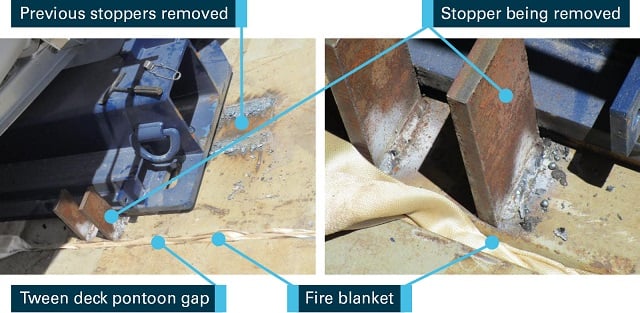Report: Initiatives After Previous Fires Not Enough
The Australian Transport Safety Bureau (ATSB) has released its investigation report into a fire on board BBC Xingang, at Newcastle on December 11, 2017, highlighting the importance of constantly monitoring hot work on board ships.
Hot works were required for the removal of sea fastenings on the ship’s tween deck. A fire watch team was arranged and fire blankets were placed in the gaps between the tween deck pontoons to protect the cargo below. However, the hot work created molten metal and other hot material that burnt through to the cargo below and ignited the cargo coverings. The fire was quickly extinguished on discovery.
The ATSB investigation found the hot work took place without the flammable nature of the cargo coverings being identified and that the fire watch team had not been directed to closely monitor the immediate area below the hot work. Therefore, the fire watch was not in position to immediately react when the molten metal fell from above. It was only when the flames and smoke were observed by the boilermaker that the response was initiated and the fire extinguished.
The fire watch consisted of two crewmembers in contact via VHF radio, one on the tween deck and the other in the lower hold. A small diameter fresh water hose was laid out and a makeshift water spray extinguisher readied for immediate use in the lower hold. Cargo in the lower hold was covered with the transport cloth but was not covered with fire blankets.

The ATSB has previously investigated two fires on board Briese Schiffahrts managed vessels in Australian ports. On both occasions the fire was started during hot work to remove sea fastenings. In the BBC Baltic fire, flammable cargo coverings were also found to have ignited. The damage caused was considerably more than that sustained on BBC Xingang.
As a consequence of the previous incidents, Briese Schiffahrts had completed significant safety actions, which were in place at the time of the current fire. These included improved shipboard procedures, risk assessments, permits to work, safety meetings and provision of equipment such as fire blankets and mats.
As a result of this fire, the company replaced fire blankets on the vessel and held a safety meeting to discuss the incident. This meeting, attended by all crewmembers, discussed the circumstances of the incident, reviewed relevant existing fleet circulars, reviewed the risk assessment and went through procedures and relating to the work and the role of the fire watch.
